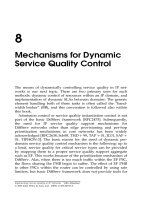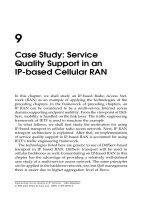Tài liệu Thực hiện tiếng nói qua IP (P1) doc
Bạn đang xem bản rút gọn của tài liệu. Xem và tải ngay bản đầy đủ của tài liệu tại đây (1.26 MB, 14 trang )
1
BACKGROUND AND
INTRODUCTION1
Implementation of real-time telephone-quality voice2 transmission using the
Internet protocol (IP, the Internet Engineering Task Force’s [IETF’s] request
for comment [RFC] 2460 and RFC 791) is no longer as challenging a task as it
was a few years ago [1,2]. In this introductory chapter, I define the instances
and interfaces of both public switched telephone networks (PSTN) and corpo-
rate or enterprise communication networks where voice over IP (VoIP) can be
implemented. The goals of VoIP implementation are to achieve (a) significant
savings in network maintenance and operations costs and (b) rapid rollout of
new services. The objective is to utilize open, flexible, and distributed imple-
mentation of PSTN-type services using IP-based signaling, routing, protocol,
and interface technologies. To achieve this, it is necessary to change the mind-
set of those responsible for the design and operations of traditional voice ser-
vices networks. Furthermore, one has to be ready to face the challenging prob-
lems of achieving reliability, availability, quality of service (QoS), and security
up to the levels that are equivalent to those of the PSTN networks.
I discuss two paradigms for implementing the VoIP service in the next sec-
tion, and then present a few scenarios in which VoIP-based telephone service
can be achieved for both residential and enterprise customers. A functionally
layered architecture is then presented that can be utilized to facilitate the sepa-
ration of call control, media adaptation, and applications and feature hosts.
Finally, I describe the organization of the rest of the book.
1
1 The ideas and viewpoints presented here belong solely to Bhumip Khasnabish, Massachusetts,
USA.
2 300 to 3400 Hz (or 3.4 KHz) of analog speech signal.
Implementing Voice over IP. Bhumip Khasnabish
Copyright
2003 John Wiley & Sons, Inc.
ISBN: 0-471-21666-6
THE PARADIGMS
The following two paradigms are most prevalent for implementation of the
VoIP service:
Server, router, and personal computer (PC)/plain old telephone service
(POTS) phone-based (mostly) flat network and
PSTN switch and mainframe computers, VoIP gateway (GW)3 and gate-
keeper (GK),4 SS7 signaling gateway (SG),5 and the POTS-phone/PC-
based (mostly) hierarchical network.
In order to provide VoIP and IP telephony services, PCs need to be equip-
ped with a full-duplex audio or sound card, a modem or network interface card
(NIC) such as an Ethernet6 card, a stereo speaker, a microphone, and a soft-
ware package for telephone (keypad, display, feature buttons, etc.) emulation.
Hardware-based IP phones can be used with a traditional PSTN network
using special adapter cards—to convert the IP packets into appropriate TDM-
formatted voice signals and call control messages—as well.
In the server-router-based networking paradigm, the servers are used for
hosting telephony applications and services, and call routing is provided by
traditional packet routing mechanisms. In the other case, the telephone features
and services can still reside in the PSTN switch and/or the adjacent mainframe
computer, and the packet-based network elements—for example, the VoIP
GW, GK, and SG—can o¤er a su‰cient amount of signaling, control, and
transport mediation services. Call routing in this case follows mainly the tradi-
tional hierarchical call routing architecture commonly utilized in the PSTN
networks.
The details of network evolution and service, network, control, and man-
agement architectures depend on the existing infrastructures and on technical,
strategic, and budgetary constrains.
VoIP FOR RESIDENTIAL CUSTOMERS
In the traditional PSTN networks, the network elements and their intercon-
nections are usually organized into five hierarchical layers [3] or tiers, as shown
3 VoIP GW translates time division multiplex (TDM) formatted voice signals into a real-time
transport protocol (RTP) over a user datagram protocol (UDP) over IP packets.
4 The GK controls one or more GWs and can interwork with the billing and management system of
the PSTN network.
5 The SG o¤ers a mechanism for carrying SS7 signaling (mainly integrated services digital network
[ISDN] user part [ISUP] and transaction capabilities application part [TCAP] messages over an IP
network. IETF’s RFC 2960 defines the stream control transmission protocol (SCTP) to facilitate this.
6 Ethernet is the protocol of choice for local area networking (LAN). It has been standardized by
the IEEE as its 802.3 protocol for media access control (MAC).
2
BACKGROUND AND INTRODUCTION
in Figure 1-1. The fifth layer contains end-o‰ce switches called CLASS-5
switches; examples are Lucent’s 5ESSS, Nortel’s DMS-100, and Siemens’
EWSD. These switches provide connectivity to the end users via POTS or a
black phone over the local copper plant or loop. In the United States, the
regional Bell operating companies (RBOCs) such Verizon, Bell-South, SBC,
and Qwest provide traditional POTS service to the residential and business
customers (or users) in di¤erent local access and transport areas (LATAs).
Implementation of VoIP for CLASS-5 switch replacement for intra-LATA
communication would require a breakdown of the PSTN switching system in a
fashion similar to breaking down the mainframe computing model into a PC-
based computing model. Therefore, one needs to think in terms of distributed
implementation of control of call, service, and information transmission. Ser-
vices that are hosted in the mainframe computer or in the CLASS-5 switches
could be gradually migrated to server-based platforms and could be made
available to end users inexpensively over IP-based networks.
VoIP can be implemented for inter-LATA (CLASS-4) and long-distance
(both national and international, CLASS-3, -2, and -1) transmission of the
voice signal as well. Figure 1-2 shows an implementation of long-distance voice
transmission using the IP network for domestic long-distance services, assum-
ing that the same company is allowed to o¤er both local and long-distance
services in the LATAs that are being interconnected by an IP network. Here
the network access from the terminal device (e.g., a black phone) can still be
provided by a traditional CLASS-5 switch, but the inter-LATA transmission of
a voice signal is o¤ered over an IP network. The resulting architecture demands
VoIP GWs to convert the TDM-formatted voice signal into IP packets at
the ingress and vice versa at the egress. The VoIP GK controls call authentica-
tion, billing, and routing on the basis of the called phone number (E.164
address) and the IP address of the terminating VoIP GK. This is a classical
implementation of VoIP service using the International Telecommunications
Union’s (ITU-T’s) H.323 [4] umbrella protocols. The same architecture can be
utilized or extended for international VoIP services, except that now the call-
originating and call-terminating VoIP GWs would be located in two countries.
Di¤erent countries usually deploy di¤erent voice signal companding schemes,
use di¤erent formatting of voice signal compression mechanisms, and prefer
di¤erent kinds of coding of signaling messages [5]. Therefore, the details of this
type of design need to be carefully considered on a case-by-case basis.
VoIP FOR ENTERPRISE CUSTOMERS
Some form of data communication network usually exists within any enterprise
or corporation. These networks commonly utilize X.25, IP, frame relay (FR),
and asynchronous transfer mode (ATM) technologies. However, recently, most
of these networks have migrated to or are planning to use IP-based networks.
Figure 1-3 shows such a network.
VoIP FOR ENTERPRISE CUSTOMERS
3
Figure 1-1
The five-layer hierarchy of a traditional PSTN consisting of CLASS-1
to 5 of central o‰ce (CO) switches. CLASS-5 COs are
commonly referred to as
end o‰ce (EO) switches and CLASS-4 COs as
tandem
switches. The private automatic branch exchanges (PBX)
are known as CLASS-6 COs as well. PBXs are used to provide
traditional and enhanced PSTN/telephony services to business customers.
4
For voice communications within the logical boundaries of an enterprise
or corporation, VoIP can be implemented in buildings and on campuses both
nationally and internationally. For small o‰ce home o‰ce (SOHO)-type ser-
vices, multiple (e.g., two to four) derived phone lines with a moderately high
(e.g., sub-T1 rate) speed would probably be su‰cient. VoIP over the digital
subscriber line (DSL; see, e.g., www.dsllife.com, 2001) channels or over coaxial
cable can easily satisfy the technical and service requirements of the SOHOs.
These open up new revenue opportunities for both telecom and cable TV ser-
vice providers.
Most medium-sized and large enterprises have their own private branch
exchanges (PBXs) for POTS/voice communication service, and hence they use
sub-T1 or T1 rate physical connections to the telephone service providers’ net-
works. They also have T1 rate and/or digital subscriber line (DSL)-type con-
nections to facilitate data communications over the Internet. This current mode
Figure 1-2 A network configuration for supporting phone-to-phone, PC-to-phone, and
PC-to-PC real-time voice telephony calls using a variety of VoIP protocols including the
session initiation protocol (SIP) and H.323 Protocols. The call control complex hosts
elements like the H.323 GK, SIP servers, Media Gateway Controller, SS7 SG, and so
on, and contains all of the packet domain call control and routing intelligence. Appli-
cations and feature servers host the applications and services required by the clients. The
network time server can be used for synchronizing the communicating clients with the
IP-based Intranet/Internet.
VoIP FOR ENTERPRISE CUSTOMERS
5









